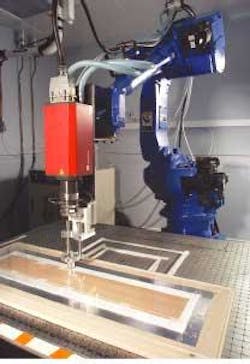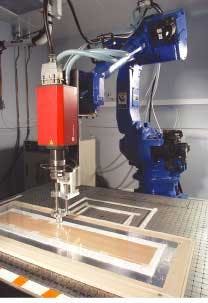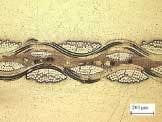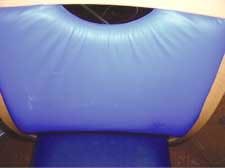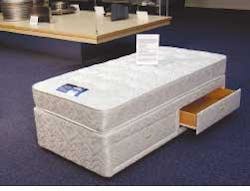Laser joining fabrics improves productivity
The use of laser welding for fabrics has been successfully demonstrated in two recently completed industrial collaborative research projects
Fabric joining is most commonly carried out using stitching. This is a highly labor intensive process, which makes production uneconomic in many parts of the world. Stitching also puts holes in the fabric, which clearly limits the performance when a sealed seam is required, and can also limit the strength of the seam produced. In searching for an automated process many companies have looked to welding or adhesive bonding, particularly for synthetic fabrics. Laser welding offers the potential for automation of manufacturing and improvements in seam performance. The main features are: high welding rate, only the joint surfaces are heated leaving the external texture unaffected, single-sided access allows welds to be carried out beneath other layers of fabric, seam flexibility is retained, and robotic or gantry manipulation of the laser provides a route to automation.
The recent projects concentrated on development of the welding process and demonstration in key application areas such as airbag construction, bed assembly, medical furniture, and protective clothing. Seam testing indicated that the seams were as good as the stitched counterparts and met the performance requirements in the applications. The continued enthusiasm by the participants for this new method is indicated by their interest in continuing the research to develop the automation methods further. There are still challenges related to the mechanized positioning of the fabrics and support of curved surfaces during welding.
Currently, the furniture upholstery industry uses manually operated sewing machines and specialized quilting machines, some with limited mechanization. Two stitch types are most commonly used: the lockstitch and over-edge stitch. The main advantage of the conventional lockstitch process is that it readily produces a strong seam in which the stitching itself has low elongation and gape under stress. The other process, over-edge stitch, is used for joining removable/detachable loose covers. Use of this type of cover is prevalent in the healthcare industry in areas such as hospitals, residential care, and nursing homes because often they are required to be easily cleaned and the continuous quest for improved infection control reinforces this requirement. In addition, coated fabric, commonly used in the healthcare industry where waterproof applications are a prerequisite, is often thermally bonded using heat-sealing or dielectric welding. Stapling is commonly used to attach fabrics to wooden or wood laminate furniture. Airbags typically have stitched seams or are woven in one piece using specialized looms.
Laser welding can be used to produce joints in either a lap or peel configuration, depending on the design and appearance required. The laser welding procedure used for textiles is based around the Clearweld method-transmission laser welding that employs specialty infrared-absorbing materials instead of carbon black to localize the laser energy and convert it to heat, melting the material at the joint. In their natural state, thermoplastics, including man-made fibers, transmit near-infrared (NIR) energy. In order to weld fabrics, radiation from a NIR laser must be absorbed at the joint. This is typically achieved by adding an infrared absorber, either by dispersing it throughout the lower layer, or as a thin layer at the joint. The traditional use of broad-spectrum absorbers, such as carbon black, adds color to the joint, which severely restricts the use of the transmission laser welding in applications where the appearance of the joint is important. This is usually the case when joining fabrics. Clearweld is used to weld clear, colored, and opaque plastics where welds need to be made without the addition of unwanted color. It was invented by TWI and has been commercialized by the Gentex Corporation (see www.clearweld.com and Industrial Laser Solutions, September 2004, page 4).
Trials showed that the infrared absorber could be applied by spraying directly onto the fabric surface or onto a polymer film, which was then positioned between the two pieces of fabric. The fabric pieces were placed on a flatbed or on a more complex three-dimensional support. After the initial positioning of the pieces with respect to each other, and with respect to the laser manipulation system, no further jigging was required. In more complex applications significant development work is still required to design flexible jigging for each shape of component. Issues such as tensioning of the fabric, asymmetrical upholstery shapes, gathering around corners, folds/tucks, and welding through multiple fabric layers must be considered in the future.
Pressure application at the seam during welding was achieved using a ring-shaped clamp sliding over a transparent cover sheet on top of the fabrics. The laser irradiated the weld through the hole in the ring. Alternatively, a vacuum table was used to apply clamping pressure.
Various NIR lasers can be used to manufacture welds using the Clearweld process, including direct or fiber-coupled diode lasers, which typically operate at wavelengths of 808 nm or 940 nm, Nd:YAG lasers operating at 1064 nm, and fiber lasers typically operating at wavelengths between 1050 nm and 1500 nm. Commercially available Clearweld absorbers have been shown to weld effectively at wavelengths between 800 and 1100 nm, and absorb laser radiation most efficiently at around 940 nm.
For this reason a 940nm direct-diode laser with output power in the 150- to 600W range with a beam width of from 3 to 10 mm was selected for this work.
The laser was manipulated using either a gantry or robotic unit (see Figure 1). In a typical robotic system the laser is mounted on a robot arm and may be manipulated in three dimensions over a complex form supporting the fabrics. If a direct-diode laser is used, then the robot carries the entire laser head. If a fiber-delivered laser is used, then the robot only carries the laser optics. A flatbed gantry system also can be considered if only two-dimensional weld seams are required. The fabrics were laid flat in the positions required for welding, a cover sheet was placed over the weld region, and pressure was applied via a clamp attached below the laser, or by vacuum through the flatbed. The joint line was then traced by moving the laser with respect to the flatbed. Although not yet implemented, other alternative systems can be envisioned for laser welding of fabrics.
Based on the survey of current practice, the following fabrics were selected for laser welding trials:
• Flat woven nylon 6,6, medium weight for airbag use
• PVC or polyurethane coated nylon, polyester, or cotton for medical furniture
• Patterned flat woven damask in various blends of polyester, polypropylene, viscose, and cotton for upholstery
• Non-woven nylon or polyester for divan upholstery
• Wood laminates (both PVC coated and paper foil coated) were used for the divan drawer demonstrators.
Following laser transmission measurements on more than 50 fabrics, it was shown that the additives and colorants were important in defining whether the fabric could be used for welding. The polymer fiber type and fabric type were less important. Fabrics with transmission values of more than 10 percent were found to be viable for use as the upper layer in welding. The transmission of the laser through the lower layer is of little consequence.
Welding was carried out at speeds from 3 to 10 m/min depending on the laser power used and the type of fabric.
Joints were evaluated for basic slippage and/or distortion, strength, and durability. Additionally, as the PU-coated fabric is intended for use in healthcare chairs, where waterproofing is prerequisite, the waterproof properties of the joint in this fabric were assessed. The airbags were tested by measuring the leak rate under a range of static pressure conditions.
Seams as strong as the parent material were achieved in the lighter-weight woven materials. The heavier airbag nylon gave weld strengths that were less than the parent strength or the stitched seam strength. Seam strengths between 40 and100 percent of the parent strength were achieved for most thermoplastic fabrics and laminates. This resulted in welds of the required strength and fatigue resistance for upholstery applications, and typically with less gape at the seam. The resistance to gape is important in retaining the appearance in upholstery, but more importantly assists in providing high performance where air or liquid sealing is required.
The strength of the seam was found to be strongly linked to the microstructure of the welds, which, in turn, is controlled by the energy input. Too little energy does not melt enough material and gives a weak weld. Too much energy melts the fabrics completely, creating a line of weakness at the edge of the weld and reducing the strength. If the energy input is correct, then controlled melting of the fabrics is achieved, the maximum weld strength is attained, and the outward appearance of the fabric is retained. A satisfactory weld microstructure is shown in Figure 2.
Demonstrator applications
Knightsbridge Furniture Productions Ltd. (West Yorkshire, U.K.) supplied a chair from its range of products, as the healthcare demonstrator. This chair is supplied into markets where a waterproof cover is needed; consequently a PU-coated polyester fabric is used. The back pad of the chair is a two-dimensional envelope that was welded inside out, turned, and pulled over the chair back providing a sealed seam. The healthcare industry requires the formation of a hermetically sealed joint to decrease bacterial penetration to the seat interior, reducing the risk of contamination and transfer of infection. Welding of the covers was successful, and the appearance was acceptable. A durability test based on an industry standard was performed on the finished chair that simulated a year of service. No significant damage was suffered. The seams passed the hydrostatic pressure leak tests. The laser-welded cover is shown in Figure 3.
Three separate bed manufacturing operations were selected as the bed set demonstrator by Silentnight Beds (Lancashire, U.K.): attaching the mattress information label, producing a welded joint in the mattress side panel border in quilted fabric, and welding the fabric onto the drawer front of the divan requiring attachment between fabric and wood.
All three of these examples were successfully welded and then subjected to industry standard testing. No visible deterioration of the seams was detected. In all three cases significant timesavings were demonstrated over the current methods. The replacement of manual stapling for the fabric-to-wood attachment for the drawer also eliminates the problem of repetitive strain injury for the stapler operators. Figure 4 shows a divan exhibiting the three laser-welded components.
Airbags are an important application for the nylon 6,6 fiber produced by INVISTA (Gloucester, UK), who were collaborators in this work. Recent developments in automotive safety have led to the introduction of airbags mounted in the sides of the seats and in the roof above the doors (curtain airbags). These provide protection from side impacts and during multiple rollover events, which require the curtain bags to stay inflated for at least 10 seconds to offer effective protection (see Figure 5). This places additional requirements on the sealing of the seams, adding extra steps to the manufacturing process. Laser welding potentially provides a rapid automated method for sealing a seam against gas or fluid leakage. Airbag demonstrator samples were prepared and tested. The results from these trials were promising with the welded seams showing leak versus pressure performance within the range of that achieved using conventionally sealed seams. The highly automated welding procedure offers the potential for cost savings by reducing the time and number of steps involved in airbag manufacture.
It is expected that the introduction of laser welding for joining fabrics can lead to increased automation and greater productivity through increasing manufacturing speed, productivity, and quality. This will reduce the drive to relocate labor-intensive sewing and stapling operations to regions with low labor costs and provide more highly skilled jobs related to the use of advanced manufacturing equipment. Producing finished goods close to where they are required will also reduce shipping costs. The process has associated benefits such as reducing the risk of repetitive strain injury and in providing a lower noise environment for operators. The potential for greater productivity offers a competitive advantage to those manufacturers able to exploit the new technology.
Further development is planned to utilize the benefits of laser welding in terms of process speed, automation, and quality improvements. Material handling, clamping, and fabric selection are particular points of interest. Laser welding is already used in some very simple applications, including synthetic textiles. It is expected that following these developments ever more complex articles will be manufactured using these techniques.
Ian Jonesis in the Advanced Materials and Process Department of TWI Ltd. in Cambridge, U.K. Contact him at [email protected] or visit www.twi.co.uk.
